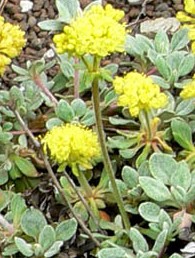 Sulfur flower, a wild buckwheat, is native to western North America where it can be found in many habitats including sagebrush scrub, meadows, and sub-alpine forests. It is member of the knotweed family, Polygonaceae, that also includes buckwheat, rhubarb, and dock. The species is very variable with over forty varieties and may be a matted herbaceous perennial four inches tall or a shrub up to six feet tall. In summer small long lasting flowers are produced in tight clusters two to four inches wide and are usually bright yellow but may be white or purple. The woolly leaves are grey-green at first and take on red coloration in autumn. Sulfur flower is very drought tolerant so is an excellent plant for xeriscapes. Unfortunately, however, it does not tolerate humidity. Bright yellow flowered varieties are especially attractive in evening gardens where they seem to glow. The genus name, Eriogonum, comes from the Greek words erion meaning wool and gony meaning knee or joint and refers to the woolliness of the nodes. The specific epithet, umbellatum, comes from the Latin word umbella, meaning a sunshade, parasol, or umbrella and refers to the arrangement of flowers on the stem that resembles the ribs of an umbrella.
Sulfur flower, a wild buckwheat, is native to western North America where it can be found in many habitats including sagebrush scrub, meadows, and sub-alpine forests. It is member of the knotweed family, Polygonaceae, that also includes buckwheat, rhubarb, and dock. The species is very variable with over forty varieties and may be a matted herbaceous perennial four inches tall or a shrub up to six feet tall. In summer small long lasting flowers are produced in tight clusters two to four inches wide and are usually bright yellow but may be white or purple. The woolly leaves are grey-green at first and take on red coloration in autumn. Sulfur flower is very drought tolerant so is an excellent plant for xeriscapes. Unfortunately, however, it does not tolerate humidity. Bright yellow flowered varieties are especially attractive in evening gardens where they seem to glow. The genus name, Eriogonum, comes from the Greek words erion meaning wool and gony meaning knee or joint and refers to the woolliness of the nodes. The specific epithet, umbellatum, comes from the Latin word umbella, meaning a sunshade, parasol, or umbrella and refers to the arrangement of flowers on the stem that resembles the ribs of an umbrella.
Type: Herbaceous perennial to medium sized shrub
Bloom: Ball like clusters of small flowers are produced in summer; may be white, yellow or purple
Size: 4-72″ H x 6-72″ W
Light: Prefers full sun but tolerates some shade
Soil: Poor, dry, very well-drained
Care: Low maintenance
Hardiness: Zones 3-8
Pests and Diseases: None of significance but susceptible to powdery mildew, rust, spider mites, aphids.
Propagation: Seed
Companion Plants: Blue flowered penstemon, cacti, yuccas.
